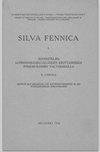Assessing feasibility of the forest trafficability map for avoiding rutting – a case study
IF 1.7
3区 农林科学
Q2 FORESTRY
引用次数: 9
Abstract
Information on forest trafficability (i.e. carrying capacity of the forest floor) is required before harvesting operations in Southern Boreal forest conditions. It describes the seasons when harvesting operations may take place without causing substantial damage to the forest soil using standard logging machinery. The available trafficability information have been based on subjective observations made during the wood procurement planning. For supporting forest operations, an open access map product has been developed to provide information on trafficability of forests. The forest stands are distributed into classes that characterize different harvesting seasons based on topographic wetness index, amount of vegetation, ground water height and ditch depth. The main goal of this case study was to evaluate the information of the static forest trafficability map in relation to the detected rutting within logging tracks measured in the field. The analysis concentrated on thinning stands since the effect of rutting is significant on the growth of the remaining trees. The results showed that the static trafficability map provided reliable and slightly conservative estimation of the forest trafficability. The majority (91.7%) of the evaluated stands were harvested without causing significant damage if harvesting was timed correctly compared to the trafficability information. However, it should be pointed out that the weather history at small scale, the skills of a driver, and effects of used machinery are not considered in the map product although they can have a considerable impact on the rutting.评估森林交通能力图避免车辙的可行性-一个案例研究
在南北方森林条件下进行采伐作业之前,需要关于森林可运输性(即森林地面的承载能力)的资料。它描述了使用标准伐木机械进行采伐作业而不会对森林土壤造成重大损害的季节。现有的可贩运性资料是根据木材采购规划期间的主观观察所得。为了支持森林作业,开发了一种开放获取地图产品,以提供关于森林可通行性的信息。根据地形湿度指数、植被数量、地下水高度和沟渠深度,将林分划分为不同采伐季节的等级。本案例研究的主要目的是评估静态森林交通能力图的信息与实地测量的伐木轨迹内检测到的车辙有关。分析集中在间伐林分,因为车辙对剩余树木的生长影响显著。结果表明,静态可通达性图对森林可通达性的估计较为可靠,且略保守。与可通行性信息相比,如果采伐时间正确,大多数(91.7%)被评估的林分没有造成重大损害。然而,应该指出的是,小尺度的天气历史、驾驶员的技能和二手机械的影响在地图产品中没有考虑,尽管它们对车辙有相当大的影响。
本文章由计算机程序翻译,如有差异,请以英文原文为准。
求助全文
约1分钟内获得全文
求助全文
来源期刊

Silva Fennica
农林科学-林学
CiteScore
3.50
自引率
11.10%
发文量
21
审稿时长
3 months
期刊介绍:
Silva Fennica publishes significant new knowledge on forest sciences. The scope covers research on forestry and forest ecosystems. Silva Fennica aims to increase understanding on forest ecosystems, and sustainable use and conservation of forest resources. Use of forest resources includes all aspects of forestry containing biomass-based and non-timber products, economic and social factors etc.
 求助内容:
求助内容: 应助结果提醒方式:
应助结果提醒方式:


